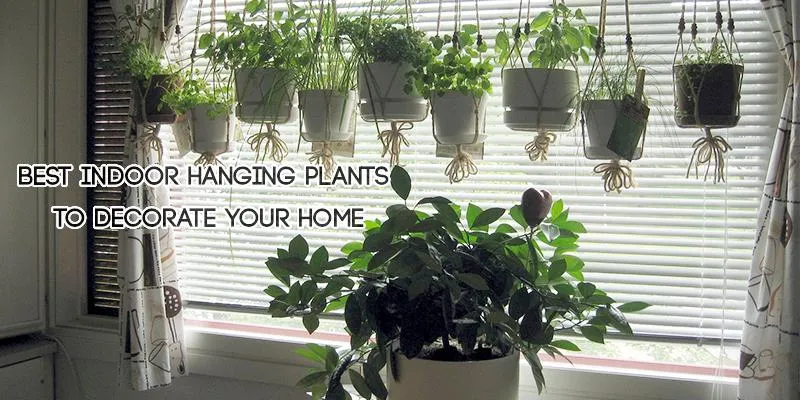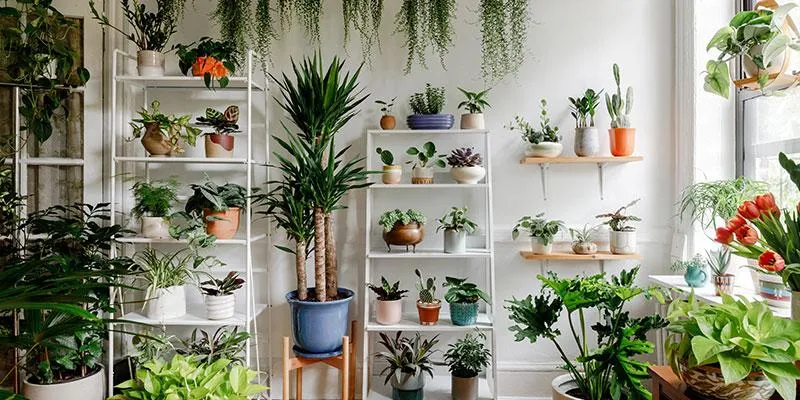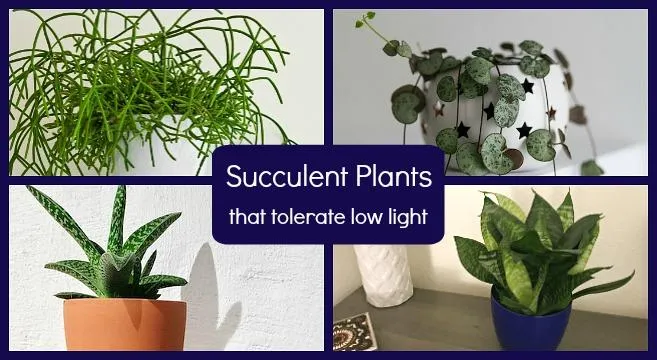The Ultimate Guide to Indoor Hanging House Plants
If you’re looking to add some greenery to your home but don’t have much floor space, indoor hanging plants are the perfect solution. From my experience decorating small apartments, hanging plants are a great way to make your space feel full and lively without taking up valuable real estate. In this article, I’ll cover everything you need to know to successfully care for hanging plants indoors, from choosing the right varieties to watering and lighting needs.
Choosing the Right Hanging Plant
The first step is selecting hanging plants that will thrive in your indoor conditions. Here are some top options to consider:
- Pothos – Known for being extremely low maintenance, pothos is one of the best indoor hanging plants. Its trailing vines can grow very long, making it perfect for hanging baskets. It also tolerates low light.
- Philodendron – Like pothos, philodendron vines beautifully from hanging pots or baskets. There are many varieties to choose from in different sizes and leaf shapes. They do well in medium to low light.
- English Ivy – This classic trailing plant looks beautiful spilling over the sides of hanging planters. English ivy thrives in low to medium light and moderate moisture.
- Spider Plant – Spider plants are tough as nails and great for beginners. Their long strappy leaves and baby plantlets dangling below make them a fun hanging plant choice. They like sunlight.
- Peperomia – There are hundreds of peperomia varieties with different colorful foliage. Some varieties like Peperomia caperata make beautiful hanging plants. They prefer medium to low indirect light.
I’ve had the most success with pothos, philodendron, and spider plants personally. They are basically indestructible and will continue trailing for years in hanging pots. Pick varieties suitable to your light conditions. Avoid plants needing high light if you don’t get much natural light indoors.
Planting and Care
Now that you’ve selected your hanging plant, it’s time to pot it up. Choose a hanging basket, planter, or pot that has holes for drainage. The pot should be large enough that the plant’s roots can grow for at least 6 months to a year before needing repotting. Use a well-draining potting mix suitable for houseplants.
Firmly plant the stem or vines in the soil and lightly tamp down. For trailing plants, let the vines spill over the sides of the planter. Water thoroughly until water drains out the bottom, then allow the top few inches of soil to dry out between waterings. Misting the leaves regularly helps with humidity loving plants.

As for light, medium to low indirect sunlight from a south or east facing window is ideal for most hanging plants. If your home gets very low light, consider supplementing with a grow light in the winter months. Fertilize hanging plants every few months in the growing season using a dilute liquid houseplant food.
Caring for Mature Hanging Plants
Over time as your hanging plants mature and put on growth from proper care, a few issues may develop that demand extra attention. One concern is mold developing in dense vines. To prevent this, I trim off any shriveled or brown aerial roots dangling below. It lets air flow through the plant.
You’ll also need to periodically repot a pot-bound plant into a slightly larger container. Signs it needs repotting include new growth slowing down and the roots filling the drainage holes. Be gentle not to damage the roots when transferring to the new pot. Top dressing with fresh potting mix can also refresh older plants.
Pruning long leggy vines back to shape the plant and maintain a full, lush appearance is sometimes necessary too. Cut vines back above a leaf node using clean pruning shears. The plant will branch out from that point. Such routine maintenance keeps hanging plants looking their best for years.
Dealing with Pests and Problems
Despite their low maintenance reputation, hanging plants are not entirely immune to pests. Common culprits include spider mites, scale, and mealybugs. Identifying signs of infestation early such as webbing, slow growth, or cotton-like spots on leaves is key.

If confronted with pests, isolate the infected plant and inspect others as a precaution. Mild soap and water or neem oil work well as natural treatments. Repeated applications may be needed to fully get rid of pests. As a last resort, consider an insecticide safe for indoor use. Removing affected leaves and pruning areas with pests helps control the situation.
Some other potential hanging plant issues involve brown leaf tips or edges which could mean overwatering, underwatering, or mineral buildup in the pot from tap water. Flush the soil occasionally with water if using tap. Brown leaves should be pruned to keep plants looking their best.
Proper care and routine maintenance should prevent many common problems from arising with indoor hanging plants. But if issues persist despite your efforts, it may be best to replace the plant if its health continues declining rapidly. I hope these tips help you achieve hanging plant success no matter the challenges!
Final Hanging Plant Care Tips
To summarize, here are some key things to remember for long-term hanging plant happiness:
- Choose varieties suitable to your light conditions that will thrive indoors long-term like pothos, philodendron, ivy, etc.
- Use the right well-draining soil mix and fertilizer for houseplants.
- Give plants adequate indirect light either from windows or grow lights as needed.
- Water thoroughly when the top inch of soil is dry and allow good drainage.
- Periodically repot into larger pots as plants outgrow containers.
- Prune off browning leaves or trim long vines back for shaping.
- Keep an eye out for pests and treat promptly with natural remedies if needed.
- Rotate hanging pots occasionally so all sides receive even light exposure.
I hope this guide has helped address all your questions about choosing, caring for, and troubleshooting issues with indoor hanging plants. Following these basic tips will ensure your plants thrive for years. Let me know if you have any other questions!

Common Indoor Hanging Houseplants
| Plant | Light Needs | Watering | Care Tips |
|---|---|---|---|
| Pothos | Low to medium | Allow top inch of soil to dry | Tolerates neglect, propagate in water |
| Philodendron | Medium | Water when top soil is dry | Toxic to pets, prune to shape |
| Spider plant | Bright indirect | Let soil dry slightly between | Propagate plantlets, air purifier |
| English ivy | Low to bright indirect | Water when top inch is dry | Vigorous grower, prune as needed |
| Peperomia | Medium to bright | Water when top inch is dry | Tolerates low light, avoid overwatering |
FAQ
-
Do indoor house plants filter air?
Kinda. Some plants like peace lilies and english ivy can take toxins out of the air in our homes. However, you would need a whole lotta plants to filter a whole room quickly. On the other hand, plants do help make indoor air feel fresher by producting oxygen.
-
What is the easiest houseplant to take care of?
Maybe the pothos or snake plant. They don’t need a ton of sunlight and can go a while without water. The snake plant is super hardy – I’ve heard it can survive weeks without a drink! At the same time, peace lilies are pretty chill too and will let you know when they need a sip.
-
How often should indoor plants be watered?
It depends on the plant. As a general rule, check the soil every week. Stick your finger in to see if the top inch or so is dry. If so, give it a good soak in the sink until water drains out the bottom. Perhaps once the palm of your hand feels warm, that’s usually a sign it could use a drink.
-
What is the best way to tell if a plant needs fertilizer?
Keep an eye out for signs your plant may be hungry. Yellowing leaves or stunted growth can happen if it’s not getting enough nutrients. You can also check the fertilizer instructions – many need it only a few times a year, usually during the growing season. It’s better not to overdo it though, as that may cause damage. Do plants get upset stomachs too?
-
Will houseplants clean the air when dust collects on the leaves?
Actually, dust can hamper a plant’s ability to filter out toxins like formaldehyde. When leaves are coated in grime, the pores can get clogged. The best way is to occasionally wipe dust off with a damp cloth. You might also try placing your plants in spots where dust won’t settle as much, like away from vents. Wonder what plant dust tastes like? Probably gross.

-
What is the best way to transport an indoor houseplant?
Before moving a plant, water it well so the soil is moist but not soaked. Then secure it in the backseat or trunk where it won’t tip over or get too much sun/wind. Covering the pot and surrounding it with a plastic bag will help keep dirt contained. It’s also a good idea to brace any tall or top-heavy plants with blankets or towels for support. With luck it’ll survive the journey – wish me and my plants safe travels!
